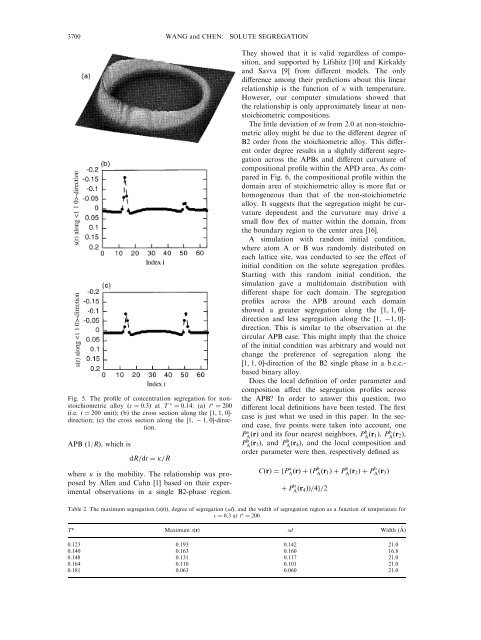solute segregation and antiphase boundary motion in a b2 single ...
solute segregation and antiphase boundary motion in a b2 single ...
solute segregation and antiphase boundary motion in a b2 single ...
Create successful ePaper yourself
Turn your PDF publications into a flip-book with our unique Google optimized e-Paper software.
3700<br />
WANG <strong>and</strong> CHEN:<br />
SOLUTE SEGREGATION<br />
Fig. 5. The pro®le of concentration <strong>segregation</strong> for nonstoichiometric<br />
alloy (c ˆ 0:3) at T ˆ 0:14: (a) t ˆ 200<br />
(i.e. t ˆ 200 unit); (b) the cross section along the ‰1, 1, 0Šdirection;<br />
(c) the cross section along the ‰1, 1, 0Š-direction.<br />
APB (1/R), which is<br />
dR=dt ˆ k=R<br />
where k is the mobility. The relationship was proposed<br />
by Allen <strong>and</strong> Cahn [1] based on their experimental<br />
observations <strong>in</strong> a s<strong>in</strong>gle B2-phase region.<br />
They showed that it is valid regardless of composition,<br />
<strong>and</strong> supported by Lifshitz [10] <strong>and</strong> Kirkaldy<br />
<strong>and</strong> Savva [9] from di€erent models. The only<br />
di€erence among their predictions about this l<strong>in</strong>ear<br />
relationship is the function of k with temperature.<br />
However, our computer simulations showed that<br />
the relationship is only approximately l<strong>in</strong>ear at nonstoichiometric<br />
compositions.<br />
The little deviation of m from 2.0 at non-stoichiometric<br />
alloy might be due to the di€erent degree of<br />
B2 order from the stoichiometric alloy. This di€erent<br />
order degree results <strong>in</strong> a slightly di€erent <strong>segregation</strong><br />
across the APBs <strong>and</strong> di€erent curvature of<br />
compositional pro®le with<strong>in</strong> the APD area. As compared<br />
<strong>in</strong> Fig. 6, the compositional pro®le with<strong>in</strong> the<br />
doma<strong>in</strong> area of stoichiometric alloy is more ¯at or<br />
homogeneous than that of the non-stoichiometric<br />
alloy. It suggests that the <strong>segregation</strong> might be curvature<br />
dependent <strong>and</strong> the curvature may drive a<br />
small ¯ow ¯ex of matter with<strong>in</strong> the doma<strong>in</strong>, from<br />
the <strong>boundary</strong> region to the center area [16].<br />
A simulation with r<strong>and</strong>om <strong>in</strong>itial condition,<br />
where atom A or B was r<strong>and</strong>omly distributed on<br />
each lattice site, was conducted to see the e€ect of<br />
<strong>in</strong>itial condition on the <strong>solute</strong> <strong>segregation</strong> pro®les.<br />
Start<strong>in</strong>g with this r<strong>and</strong>om <strong>in</strong>itial condition, the<br />
simulation gave a multidoma<strong>in</strong> distribution with<br />
di€erent shape for each doma<strong>in</strong>. The <strong>segregation</strong><br />
pro®les across the APB around each doma<strong>in</strong><br />
showed a greater <strong>segregation</strong> along the ‰1, 1, 0Šdirection<br />
<strong>and</strong> less <strong>segregation</strong> along the ‰1, 1, 0Šdirection.<br />
This is similar to the observation at the<br />
circular APB case. This might imply that the choice<br />
of the <strong>in</strong>itial condition was arbitrary <strong>and</strong> would not<br />
change the preference of <strong>segregation</strong> along the<br />
‰1, 1, 0Š-direction of the B2 s<strong>in</strong>gle phase <strong>in</strong> a b.c.c.-<br />
based b<strong>in</strong>ary alloy.<br />
Does the local de®nition of order parameter <strong>and</strong><br />
composition a€ect the <strong>segregation</strong> pro®les across<br />
the APB? In order to answer this question, two<br />
di€erent local de®nitions have been tested. The ®rst<br />
case is just what we used <strong>in</strong> this paper. In the second<br />
case, ®ve po<strong>in</strong>ts were taken <strong>in</strong>to account, one<br />
P a A …r† <strong>and</strong> its four nearest neighbors, Pb A …r 1†, P b A …r 2†,<br />
P b A …r 3†, <strong>and</strong> P b A …r 4†, <strong>and</strong> the local composition <strong>and</strong><br />
order parameter were then, respectively de®ned as<br />
C…r† ˆfP a A …r†‡…Pb A …r 1†‡P b A …r 2†‡P b A …r 3†<br />
‡ P b A …r 4††=4g=2<br />
Table 2. The maximum <strong>segregation</strong> (s(r)), degree of <strong>segregation</strong> (sd), <strong>and</strong> the width of <strong>segregation</strong> region as a function of temperature for<br />
c ˆ 0:3 att ˆ 200<br />
T* Maximum s(r) sd Width (A Ê )<br />
0.123 0.193 0.142 21.0<br />
0.140 0.163 0.160 16.8<br />
0.148 0.131 0.117 21.0<br />
0.164 0.110 0.101 21.0<br />
0.181 0.063 0.060 21.0
















